Quick Look: PowerColor’s Radeon HD 5770 PCS+ Vortex Edition
by Ryan Smith on August 25, 2010 11:22 AM EST- Posted in
- GPUs
- AMD
- Radeon
- PowerColor
Power, Temperature, & Noise
For our look at power, temperature, & noise, we’ve run the Vortex with the fan both retracted and extended. As we normally test cards with the fan speed on automatic we’ve gone ahead and continued this practice here, though we’ll note that the fan position had absolutely no effect on what speed the card ultimately chose to run the fan at, likely because of the nearly non-existent difference in temperature.
For our charts here, the Vortex's fan is in its lowered position unless otherwise noted.
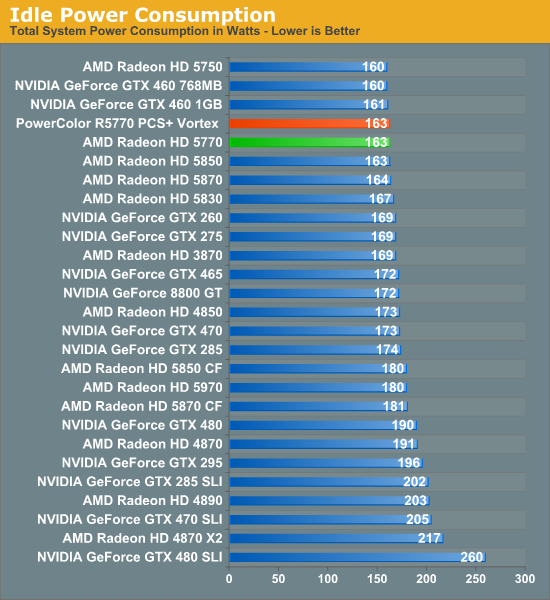
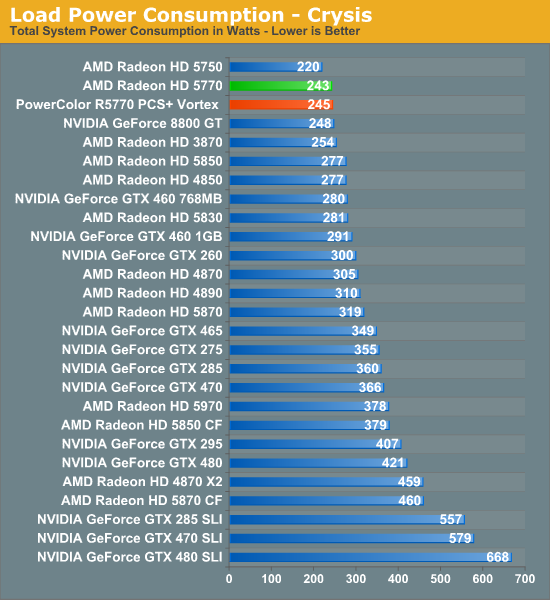
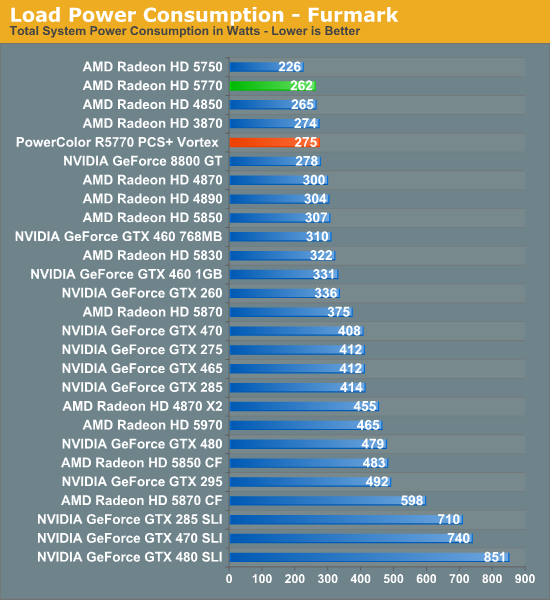
At idle, power consumption is unchanged from our reference 5770. Under load the Vortex ends up drawing slightly more power, which is to be expected due to the card’s slight overclock. Under Crysis this amounts to 2W more power draw, while FurMark sees a much more noticeable rise of 13W. All things considered we’re surprised to see that the power draw of the Vortex differ from the 5770 by so little – usually a shorter card has to give up some power efficiency in order to make the shorter length possible, but this is not the case for the Vortex.
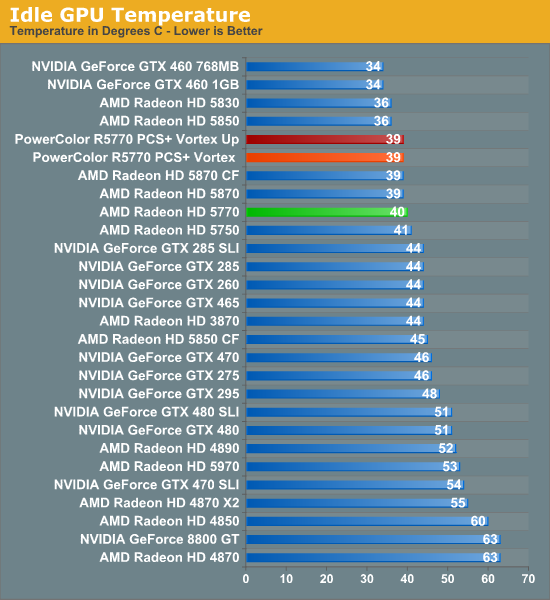
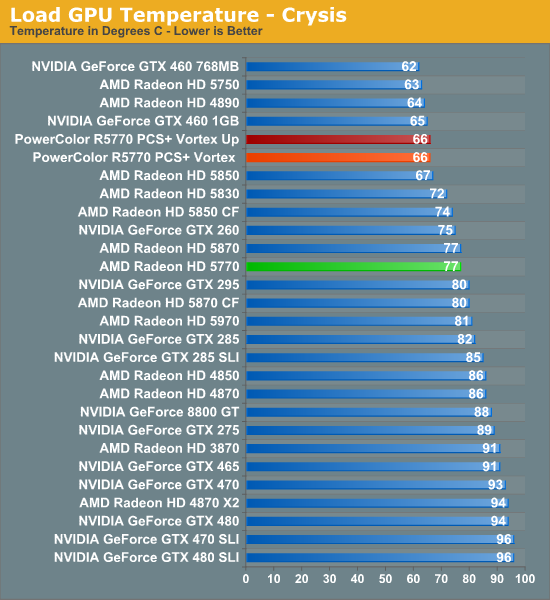
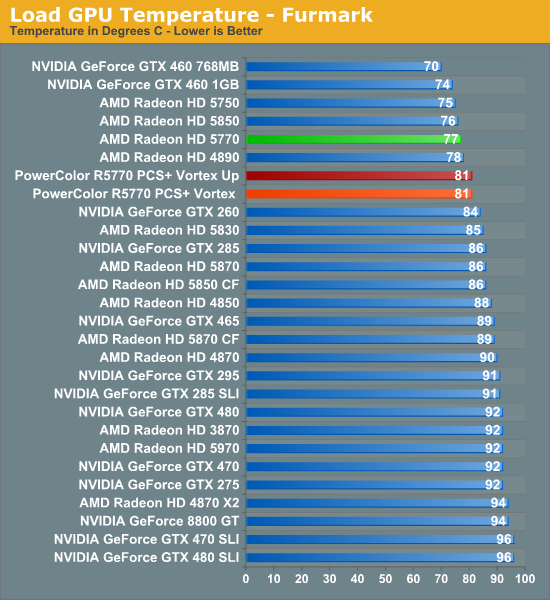
Moving on to temperatures, we have two different stories to look at. For idle temperatures the Vortex ends up being a mere 1C cooler than our reference 5770, an unsurprising outcome since idle temperatures vary little for any given GPU once you move to an appropriately large cooler.
Meanwhile the load temperatures are much more interesting – under Crysis our Vortex is an amazing 11C cooler than our reference 5770, while under FurMark the Vortex is 4C hotter. This is a much bigger discrepancy between Crysis and FurMark than what we see with our reference 5770, and after some digging the reason appears to be the fan profile in use. The Vortex has a more aggressive fan profile that results in it ramping up the fan sooner than the reference 5770 leading to the cooler Crysis temperatures, while under a very high load like Furmark the difference in how the two fans ramp up become much less pronounced. This is why the Vortex can be cooler under Crysis while running warmer under FurMark. Disregarding fan profiles, the Vortex cooler would appear to be ever so slightly less efficient than the reference cooler, which may be a benefit of the reference 5770’s embedded-fan design.
For our look at temperatures, the configuration of the Vortex’s fan had no impact on the temperature the card settled at. Retracted or extended resulted in the same temperatures, and indeed the same fan speed.
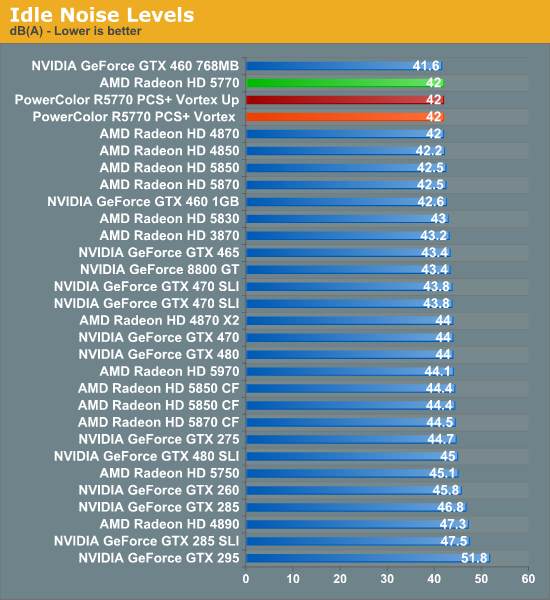
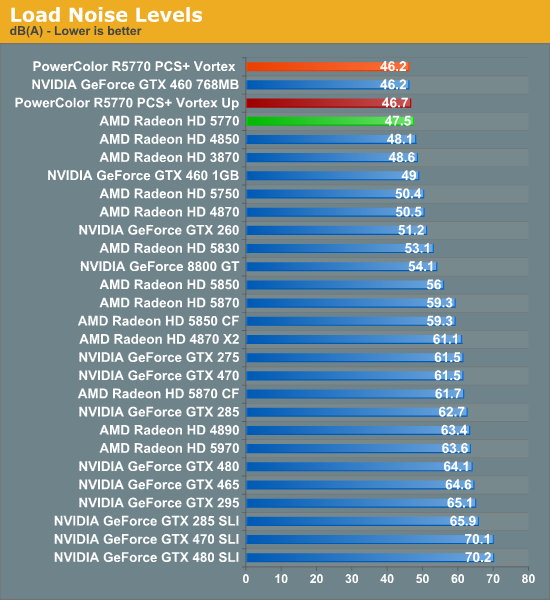
Last but not least we have noise. At idle our noise results are in-line with the reference 5770 and our other quieter cards, with all of those cards running in to the noise floor of testing environment. Under load we do find a difference between the Vortex and the reference 5770, however it’s only the slightest difference. The Vortex ends up being around 1dB(A) quieter than the reference 5770, which is something that we can measure but not something we could realistically perceive.
As for testing the Vortex’s fan, extending it had a slightly negative impact on the amount of noise generated under load. The card was at its quietest when the fan was retracted, generating 46.2dB(A) of noise, while extending it made the card 0.5dB(A) louder. It’s an academic difference at best, but one showcasing how the heatsink and the body of the card serve to muffle the noise from the fan by a slight degree.
Ultimately we have two things to take away from these results. The first is that when it comes to temperature and noise, the Vortex’s design simply doesn’t produce remarkably different results from the reference 5770. The Crysis results are very impressive, but this has more to do with the ramping profile of the card’s BIOS than it does the hardware. Under similar circumstances the Vortex’s cooler is slightly less efficient and slightly quieter than the reference cooler, which isn’t a bad tradeoff given the otherwise outstanding Crysis results.
The second thing we can take away is that the Vortex’s adjustable fan is little more than a gimmick. The only thing raising the fan accomplished is to make the card ever so slightly louder, but it didn’t do anything for cooling. We’ll grant PowerColor high scores here for effort, but it’s a very good thing for PowerColor that the adjustable fan doesn’t appear to have any negative impact on the card when it’s retracted, as this means the fan is merely an intellectual curiosity rather than a more serious design flaw.
All-told there is one good thing to come from the fan however: it’s easily removable. A removable fan makes it easier to clean the card without having to remove the heatsink or the shroud, the latter of which is held down by 4 very small screws.










26 Comments
View All Comments
Ryan Smith - Thursday, August 26, 2010 - link
Data for lower-end cards will be coming next month. We have to build a new benchmark suite for those cards, and it takes (a lot of) time to gather that data.Phynaz - Thursday, August 26, 2010 - link
Charts are way two crowded. You're comparing two 5770's, we don't need results from SLI GTX480's.LoneWolf15 - Thursday, August 26, 2010 - link
PCB of the card is definitely not reference-design, and looks "cheaped down". Only one crossfire connector. Also, note that the reference design 5770 had three-phase power. A number of aftermarket cards cut down to two phases to save $$$.Since there are few, if any 5770 reference-design cards left on the market (might be a few from Diamond, but most manufacturers have switched), I normally look at ASUS, one of the few vendors that actually designed their reference cards to be equal or better, rather than to save costs. Other vendors like XFX, Sapphire, and (apparently) PowerColor seem to be going the other way.
LoneWolf15 - Thursday, August 26, 2010 - link
After checking, it seems even ASUS may have cut down their 5770 card. The only two left I'd be interested in are MSI's HAWK 5770, and Diamond's 5770PE51G, which (if you can find one) should be a reference design.The downside to Diamond is that customer support is a real crap-shoot. I guess that would leave me looking for a used reference-design 5770 on Ebay; they're still the best version of the card.
shin0bi272 - Thursday, August 26, 2010 - link
Come to think of it if the coolers we have now had something like heat pipes in them instead of fins we could still be getting away with single slot coolers. A gang of oil filled tubes with radial fins extending from the gpu to the ends of the card and one or two going over the ram bank (maybe in a loop) with a 12 bladed 92x5mm fan (or maybe 2 if you wanted to cover the entire card) could offer enough cooling in a cost effective design for the card makers to offer them stock instead of everyone having to buy aftermarket coolers. Granted an aftermarket cooler isnt hard to put on but it does void your warranty which sucks if the card dies.LoneWolf15 - Friday, August 27, 2010 - link
It doesn't void the warranty for every company.XFX (and possibly some others) know that a user might want to water cool their card, so the warranty isn't void for removing the cooler, as long as you don't screw the card up in the process. In my case, I removed the cooler from my reference 5870-XXX Edition almost immediately, to replace the TIM. I found the factory had really glopped it on, so I re-applied it more conservatively, which improved GPU temperatures slightly.